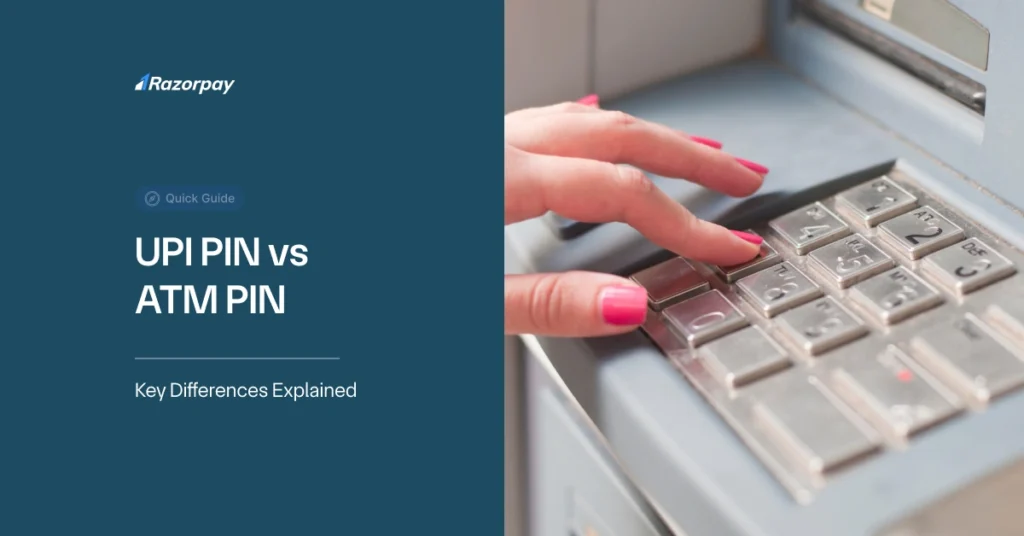UPI PIN vs ATM PIN: Key Differences Explained
In the world of digital payments and banking, two types of PINs often come up — the UPI PIN and the ATM PIN. While they might look similar at first glance, understanding how these PINs differ is crucial for secure transactions. This guide will break down what makes the UPI PIN and ATM PIN unique, their different uses, and how you can keep your transactions safe.
UPI PIN vs ATM PIN: A Detailed Breakdown
Here’s a simple comparison of the UPI PIN and ATM PIN across several important aspects:
1. Usage
- UPI PIN: Used specifically for authorizing transactions on UPI platforms, such as sending money via your UPI ID or approving payments in apps like Google Pay, PhonePe, or Razorpay.
- ATM PIN: Used at ATMs for withdrawing cash, checking balance, or making other card-related transactions, including UPI ATM cash withdrawal where applicable.
2. Types of Transactions
- UPI PIN: Authorizes digital payments and transfers directly from your bank account without the need for a physical card.
- ATM PIN: Required for physical card-based transactions at ATMs or point-of-sale machines.
3. Security Features
- Both PINs act as a security layer but serve different purposes. The UPI PIN secures your mobile-based transactions, often paired with device-level security (like biometrics). The ATM PIN secures card-based transactions.
4. How They Are Created
- UPI PIN: Set up during the MPIN registration or the first time you link your bank account with a UPI app. You can change or reset it via the app.
- ATM PIN: Provided by your bank when you receive your debit/credit card. It can be changed via ATM or bank services.
5. Convenience and Accessibility
- The UPI PIN allows seamless, cardless payments directly from your smartphone, ideal for quick digital transactions.
- The ATM PIN is essential when using physical cards for cash withdrawals or in-store purchases.
How to Secure Your Transactions with UPI PIN and ATM PIN?
Security is paramount when dealing with either PIN:
- Never share your UPI PIN or ATM PIN with anyone.
- Use strong, unique PINs instead of easy-to-guess numbers like “1234” or birth years.
- Regularly update your PINs to reduce the risk of fraud.
- Enable two-factor authentication (2FA) on your UPI apps for an added layer of security.
- Activate transaction alerts for both UPI and ATM card usage to monitor suspicious activity in real-time.
Conclusion
While the UPI PIN and ATM PIN might seem similar, they serve distinct roles in today’s banking ecosystem. The UPI PIN focuses on securing digital UPI payments, whereas the ATM PIN protects physical card transactions like cash withdrawals. Understanding these differences helps you use both PINs confidently and securely.
Frequently Asked Questions (FAQs)
1. Do UPI PINs and ATM PINs serve the same purpose?
No, the UPI PIN is for authorizing digital UPI payments, while the ATM PIN is for physical card transactions like withdrawals and balance checks.
2. Which PIN is more secure: UPI PIN or ATM PIN?
Both provide security in their contexts. The UPI PIN is paired with app security, and the ATM PIN is secured by physical card possession.
3. Is it safe to use the same number for UPI PIN and ATM PIN?
It’s advisable to use different PINs for added security and to minimize risks if one PIN is compromised.
4. What should I do if I suspect fraudulent activity involving my UPI or ATM PIN?
Immediately change your PINs, inform your bank, and report any suspicious transactions through your banking app or customer service.
This clear understanding of UPI PIN vs ATM PIN ensures you manage your banking security effectively, whether you’re making quick UPI transactions or withdrawing cash at an ATM. Stay safe and keep your PINs private!



